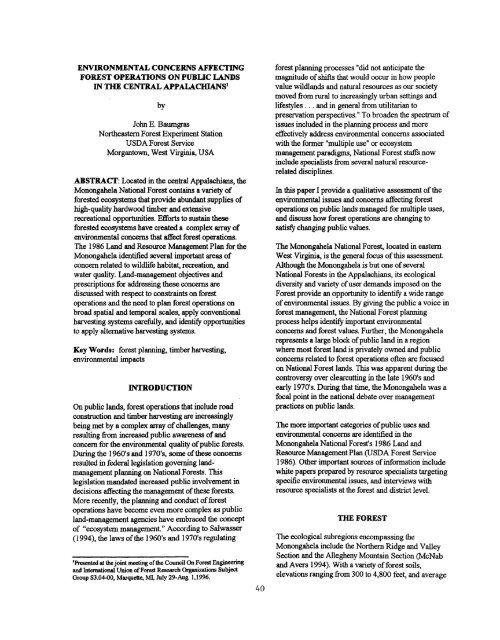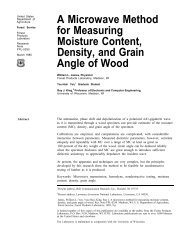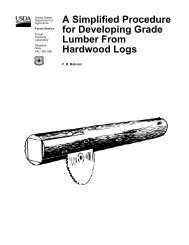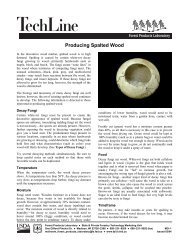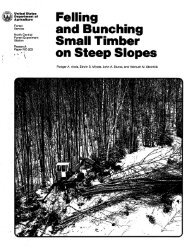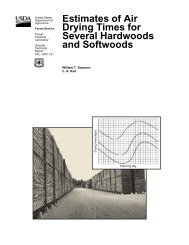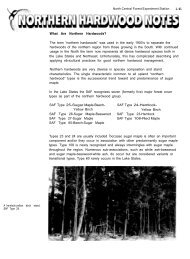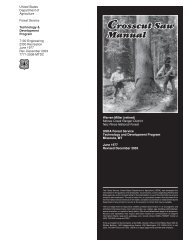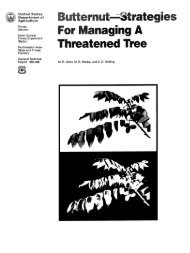Planning and implementing forest operations to achieve ... - Woodweb
Planning and implementing forest operations to achieve ... - Woodweb
Planning and implementing forest operations to achieve ... - Woodweb
Create successful ePaper yourself
Turn your PDF publications into a flip-book with our unique Google optimized e-Paper software.
ENVIRONMENTAL CONCERNS AFFECTING <strong>forest</strong> planning processes "did not anticipate the<br />
FOREST OPERATIONS ON PIJBLIC LANDS magnitude of shifts that would occur in how people<br />
IN THE CENTRAL APPALACIHANS _<br />
value wildl<strong>and</strong>s <strong>and</strong> natural resources as our society<br />
moved from rural <strong>to</strong> increasingly urban settings <strong>and</strong><br />
by lifestyles.., <strong>and</strong> in general from utilitarian <strong>to</strong><br />
preservation perspectives." To broaden the spectrum of<br />
John E. Baumgras<br />
issues included in the planning process <strong>and</strong> more<br />
Northeastern Forest Experiment Station effectively address environmental concerns associated<br />
USDA Forest Service<br />
with the former "multiple use" or ecosystem<br />
Morgan<strong>to</strong>wn, West Virginia, USA<br />
management paradigms, National Forest staffs now<br />
include specialists from several natural resourcerelated<br />
disciplines.<br />
ABSTRACT: Located in the central Appalachians, the<br />
Monongahela National Forest contains a variety of<br />
In this paper I provide a qualitative assessment of the<br />
<strong>forest</strong>ed ecosystems that provide abundant supplies of environmental issues <strong>and</strong> concerns affecting <strong>forest</strong><br />
high-quality hardwood timber <strong>and</strong> extensive<br />
<strong>operations</strong> on public l<strong>and</strong>s managed for multiple uses,<br />
recreational opportunities. Efforts <strong>to</strong> sustain these<br />
<strong>and</strong> discuss how <strong>forest</strong> <strong>operations</strong> are changing <strong>to</strong><br />
<strong>forest</strong>ed ecosystems have created a complex array of<br />
satisfy changing public values.<br />
environmental concerns that affect <strong>forest</strong> <strong>operations</strong>.<br />
The 1986 L<strong>and</strong> <strong>and</strong> Resource Management Plan for the The Monongahela National Forest, located in eastern<br />
Monongahela identified several important areas of<br />
West Virginia, is the general focus of this assessment.<br />
concern related <strong>to</strong> wildlife habitat, recreation, <strong>and</strong><br />
Although the Monongahela is but one of several<br />
water quality. L<strong>and</strong>-management objectives <strong>and</strong> National Forests in the Appalachians, its ecological<br />
prescriptions for addressing these concerns are<br />
diversity <strong>and</strong> variety of user dem<strong>and</strong>s imposed on the<br />
discussed with respect <strong>to</strong> constraints on <strong>forest</strong><br />
Forest provide an opportunity <strong>to</strong> identify a wide range<br />
<strong>operations</strong> <strong>and</strong> the need <strong>to</strong> plan <strong>forest</strong> <strong>operations</strong> on<br />
of environmental issues. By giving the public a voice in<br />
broad spatial <strong>and</strong> temporal scales, apply conventional<br />
<strong>forest</strong> management, the National Forest planning<br />
harvesting systems carefully, <strong>and</strong> identify opportunities process helps identify important environmental<br />
<strong>to</strong> apply alternative harvesting systems,<br />
concerns <strong>and</strong> <strong>forest</strong> values. Further, the Monongahela<br />
represents a large block of public l<strong>and</strong> in a region<br />
Key Words: <strong>forest</strong> planning, timber harvesting, where most <strong>forest</strong> l<strong>and</strong> is privately owned <strong>and</strong> public<br />
environmental impacts<br />
concerns related <strong>to</strong> <strong>forest</strong> <strong>operations</strong> often are focused<br />
on National Forest l<strong>and</strong>s. This was apparent during the<br />
controversy over clearcutting in the late 1960's <strong>and</strong><br />
INTRODUCTION<br />
early 1970's. During that time, the Monongahela was a<br />
focal point in the national debate over management<br />
On public l<strong>and</strong>s, <strong>forest</strong> <strong>operations</strong> that include road<br />
practices on public l<strong>and</strong>s.<br />
construction <strong>and</strong> timber harvesting are increasingly<br />
being met by a complex array of challenges, many<br />
The more important categories of public uses <strong>and</strong><br />
resulting from increased public awareness of <strong>and</strong><br />
environmental concerns are identified in the<br />
concern for the environmental quality of public <strong>forest</strong>s. Monongahela National Forest's 1986 L<strong>and</strong> <strong>and</strong><br />
During the 1960's <strong>and</strong> 1970's, some of these concerns Resource Management Plan (USDA Forest Service<br />
resulted in federal legislation governing l<strong>and</strong>-<br />
1986). Other important sources of information include<br />
management planning on National Forests. This<br />
white papers prepared by resource specialists targeting<br />
legislation m<strong>and</strong>ated increased public involvement in<br />
specific environmental issues, <strong>and</strong> interviews with<br />
decisions affecting the management of these <strong>forest</strong>s,<br />
resource specialists at the <strong>forest</strong> <strong>and</strong> district level.<br />
More recently, the planning <strong>and</strong> conduct of <strong>forest</strong><br />
<strong>operations</strong> have become even more complex as public<br />
l<strong>and</strong>-management agencies have embraced the concept<br />
THE FOREST<br />
of "ecosystem management." According <strong>to</strong> Salwasser<br />
(1994), the laws of the 1960's <strong>and</strong> 1970's regulating The ecological subregions encompassing the<br />
Monongahela include the Northern Ridge <strong>and</strong> Valley<br />
Section <strong>and</strong> the Allegheny Mountain Section (McNab<br />
_PresentedatthejointmeetingoftheCouncilOnForestEngineering<br />
<strong>and</strong>InternationalUnionofForestResearchOrganizations Subject<br />
<strong>and</strong> Avers 1994). With a variety of <strong>forest</strong> soils,<br />
Group $3.04-00, Marquette, ML July 29-Aug, 1,1996. elevations ranging from 300 <strong>to</strong> 4,800 feet, <strong>and</strong> average<br />
40


